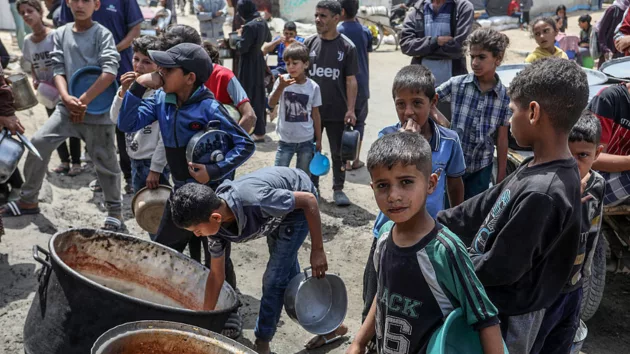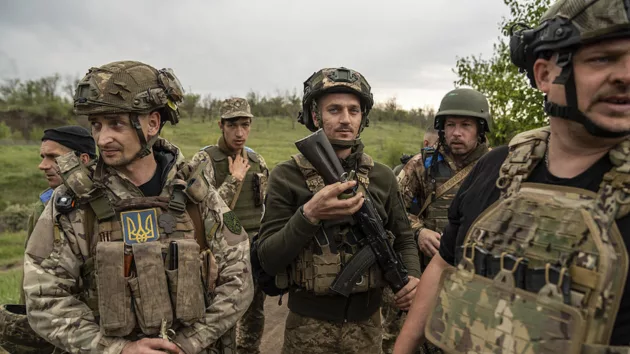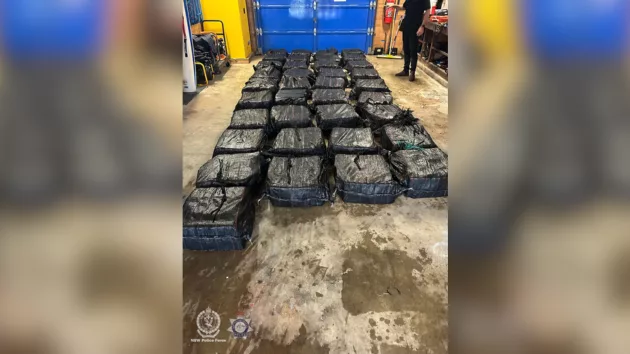(GAZA) — Gaza’s entire population is experiencing critical levels of hunger amid the ongoing Israel-Hamas war and the third month of Israel cutting off aid to the strip, according to a report published Monday.
Gaza’s 2.1 million residents will face a “crisis” level of food insecurity — or worse — from now through the end of September, according to a new report from the Integrated Food Security Phase Classification partnership, whose members include the World Health Organization.
“Crisis” is the third-highest level of food insecurity, out of five, according to the IPC classification system. This is when households are either struggling to access food and are seeing cases of malnutrition or “are marginally able to meet minimum food needs but only by depleting essential livelihood assets,” according to the IPC.
Of the entire population, three-quarters of Gaza’s population are already classified at the “emergency” or “catastrophe” levels, which are the two worst stages of food insecurity, per the IPC.
The report projected that by the end of September, about 470,000 people Gaza, equivalent to about 22% of the population, will be classified as living under “catastrophe,” which is equivalent to famine levels of starvation.
In the previous IPC report, released in October 2024, 12% of the population was projected to be under classified as living under “catastrophe.”
The IPC said famine is classified when an area has 20% of households facing an extreme lack of food, 30% of children suffering from acute malnutrition, and two of every 10,000 people dying each day due to starvation or a combination of malnutrition and disease.
In a press release, the WHO said the situation in Gaza is “one of the world’s worst hunger crises, unfolding in real time.”
“We do not need to wait for a declaration of famine in Gaza to know that people are already starving, sick and dying, while food and medicines are minutes away across the border,” WHO Director-General Dr. Tedros Adhanom Ghebreyesus said in a statement on Monday. “Today’s report shows that without immediate access to food and essential supplies, the situation will continue to deteriorate, causing more deaths and descent into famine.”
Ingredients have started running out in Gaza, and some food relief organizations have already closed.
In late April, the United Nations’ World Food Programme said it had delivered its last remaining food stocks to hot meal kitchens in Gaza, and it expected to fully run out of food in the coming days.
Additionally, the nonprofit group World Central Kitchen announced on Wednesday that it had run out of supplies and ingredients needed to cook meals or bake bread in Gaza.
“Families in Gaza are starving while the food they need is sitting at the border. We can’t get it to them because of the renewed conflict and the total ban on humanitarian aid imposed in early March,” Cindy McCain, executive director of the United Nations World Food Programme, said in a statement. “It’s imperative that the international community acts urgently to get aid flowing into Gaza again. If we wait until after a famine is confirmed, it will already be too late for many people.”
The Israeli government said the blockade is meant to pressure Hamas to release its hostages, as well as the remains of those who have died, and to accept a new proposal to extend phase one of the ceasefire deal, which ended March 18.
The WHO said that since the blockade began, 57 children have died from malnutrition, citing figures from the Hamas-run Gaza Ministry of Health. If the current situation persists, an estimated 70,500 children between ages 6 months and just under 5 years old will experiencing acute malnutrition by March 2026, according to the IPC report.
Pregnant and breastfeeding women are also at risk with nearly 17,000 expected to need treatment for acute malnutrition by March 2026.
Aid workers told ABC News that malnutrition makes it harder for Gazans to heal from injuries suffered during the war, and they can also be at risk of infections or skin graft failure.
An official from President Donald Trump’s administration told ABC News there is a not-yet-finalized plan to administer the delivery of humanitarian aid in Gaza, starting with fewer than half a dozen distribution sites set up throughout the enclave.
“Our team members inside Gaza are surviving on the cheapest staples they can find — lentils, fava beans, dry chickpeas — if anything is available at all,” Kate Phillips-Barrasso, vice president of global policy and advocacy for the humanitarian organization Mercy Corps, said in a statement. “The people of Gaza are enduring one of the most harrowing humanitarian crises in recent history.”
“All barriers to food, water, and aid must be lifted now,” she said, “before even more lives are lost.”
Copyright © 2025, ABC Audio. All rights reserved.






